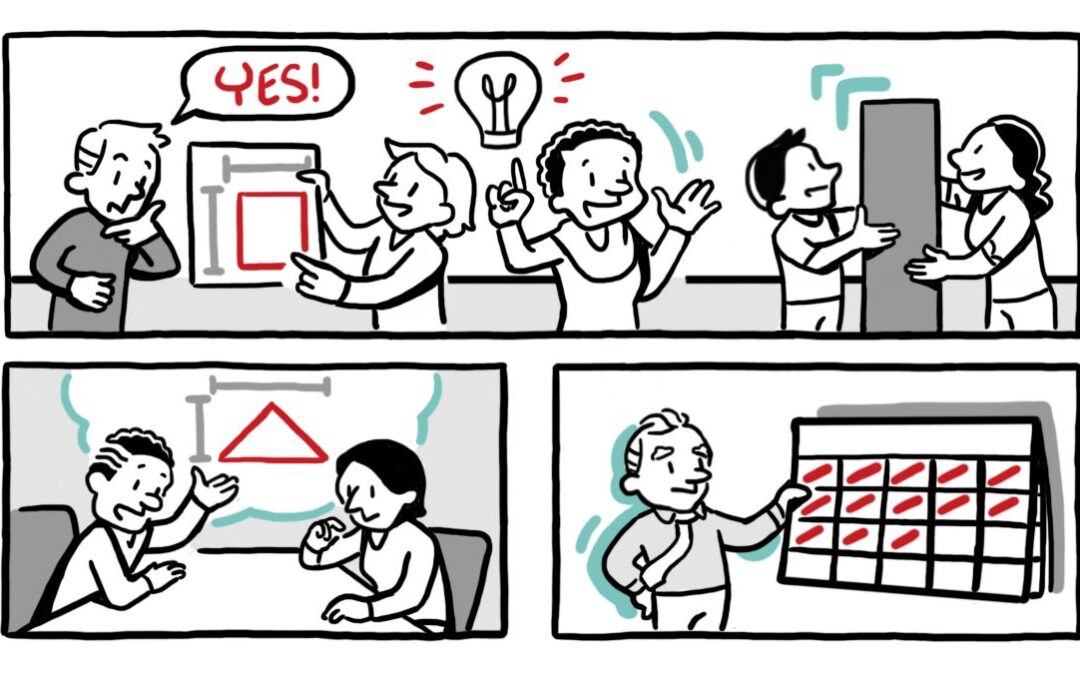A siloed work experience is a problematic one. This is well-acknowledged throughout the business world, and yet reversing the trend remains harder than spotting it. Let’s take a look at what it means to be siloed, how businesses can best approach breaking down silos, and what kinds of benefits businesses can expect as that breakdown proceeds.
Defining Our Terms
“A silo is a system that separates different types of employees, usually according to the department in which they work.” This definition from Dropbox is a great place to start. We can also benefit from this addition: “Organizational silos… refer to how teams work—and not in an especially positive way.”
It’s not a problem to have “a range of specialist, small-scale teams,” they write; any business will (and should) naturally group employees by skill and function to some extent.
Imagine two groups of people in large room. We’ll call them Team Lightning and Team Thunder. It’s fine that members of Team Lightning does not do the same job that members of Team Thunder—this alone does not create silos.
How Do they Happen?
As the Dropbox definition explains, silos rise out of separation. So let’s imagine both teams in different locations, with the bare minimum of communication and almost no understanding of the functions of the other teams. This is a siloed environment.
Sounds troublesome, doesn’t it? Unfortunately, silos can have impacts that ripple all the way out to your customers. Salesforce Canada details three of the worst results of siloed employees: wasted money, ineffective learning, and lost customers.
Dangers Include…
On the first point, the example of technological integration helps see a broader issue that can occur with “any project in a big company… when teams are siloed, deadlines get missed, mistakes get made and budgets that should have been the foundation for success stories lead to failures instead.”
At first, this might seem like an ambitious list (in the worst way), but it does follow from the effects of siloed employees. When teams are unaware of the functions of other teams, how can they allocate time and resources properly to a project that involves multiple teams?
Should production go ahead with a new design, or should they wait for approval? Does production know whose approval they require, or how long it takes to attain it? How much time has marketing had to prepare for the rollout—if any?
Productivity, Learning, and More
Clearly, silos are a recipe for misspent funds and misallocated hours. That leads us into learning, which silos force organizations to keep “inward-facing because they have to fix things that are broken.” Instead of the ideal state of “constant learning about their customers, the market and how to continue delivering value in greater or more varied ways,” learning becomes a game of catch-up.
When silos prevent clear communication and collaboration, productivity can occur in areas that don’t produce the results your organization needs. They also create duplicated work and effort, and tie up personnel trying to uncover solutions to problems. Learning stays in-house, never contributing to customer delight, innovation, or anything other than inefficient problem-solving.
With these two sizable downsides in mind, it’s easy to see the third result of siloed work environments: lost customers. Salesforce Canada writes, “As a customer, you don’t have the time or interest in getting everyone aligned. Breaking down silos is not your job.”
People don’t buy from companies that greet them with a disorganized, dysfunctional buyer journey. You’d likely walk away from a business that met your interest with delays and inaccurate (or incomplete) answers to your questions. Your customers will similarly walk away from yours if this is how you show up to them.
Reversing the Trend
So, how can you break down silos? Laura McPherson suggests a number of initiatives designed to bring functions into shared understanding (“Help everyone understand the common vision and goals”, “Assign cross-functional liaisons”) and reduce the disconnected nature of a siloed environment.
McPherson even goes beyond understanding and guidance to suggest that you encourage cross-functional training. She notes that while “specialization is a good thing… at the same time, team members need to understand how their peers fit into the bigger picture.”
It’s understandable if this advice feels a bit idealistic. Will there be time to train team members in other functions’ duties? Will they even want to learn these additional skills and roles?
Fortunately, you control the answer to the first question. And when it comes to interest, you control some of that as well; respectfully providing employees the rationale behind cross-functional training can go a long way to increasing their desire to better understand the day-to-day of their peers.
Involve Them Early
McPherson also leverages an interesting phenomenon: “the IKEA effect,” which “states that people who put creative effort into the beginning stages of a process will be more invested down the line.”
Emerson Dameron expands on this idea as part of a piece on cognitive biases in the workplace, writing that as contributors to a project, “We’re not prioritizing the object/project as much as we are the resources we’ve put into it.” Dameron suggests a few ways to make the IKEA effect work for you: “…designers and copywriters may want to learn basic coding, so they can take more active roles in how their work appears online,” and “various stakeholders can contribute their ideas in the beginning.”
The commonality between all silo-busting efforts can be summed up with the phrase “get everyone involved.” Target areas of disconnect and attack them with training for cross-functional unity. Consider technological upgrades for improved communications. Leverage cognitive tendencies to drive investment.
CJ Haughey provides a succinct summary of why eliminating silos matters: “Breaking down the silo mentality helps create trust between teams and builds a path to sustained growth and profitability.” Take the time to dissemble silos—your teams, and your profits, will thank you.

